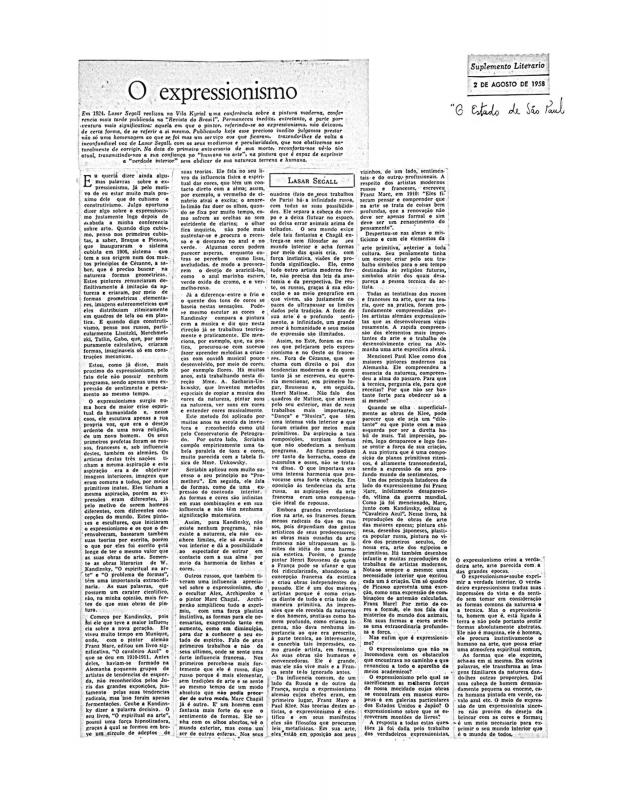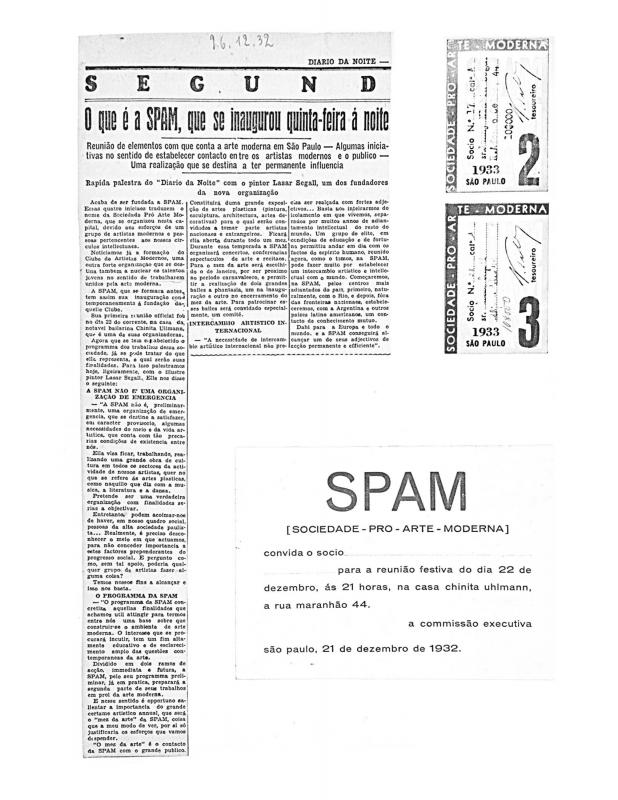Lasar Segall (1891–1957) was born in Vilnius, Lithuania, where his family was part of the Jewish community. He enrolled in the School of Applied Arts in Berlin and, in the early years of the century, spent time at the Academy of Fine Arts. He traveled to Brazil—where his brothers already resided—in 1912. The Centro de Ciências e Artes de Campinas (SP) acquired his work titled Cabeça de menina russa (1908). He returned to Europe during the First World War. He founded the Dresdner Sezession – Gruppe in 1919 with other German painters (such as Otto Dix). He established a link with Kandinsky after an exhibition in Hanover (1921) on Russian art. In 1923, Segall returned to the Brazil. He painted a mural at the Pavilhão de Arte Moderna, a meeting place for artists and intellectuals at the home of the great promoter of the Semana de Arte Moderna of 1922, Mrs. Olivia Guedes Penteado. Of Jewish origin, Segall personally witnessed the adversity confronted by the Semitic communities throughout his career. Painted in 1937, the work Pogrom (which in Yiddish means “devastation”) illustrates the enormous anti-Semitic massacres that occurred in Russia during the century. In this document, the critic Geraldo Ferraz limits his analysis to documenting the formal aspects of the canvas; although confirming the pictorial autonomy of the work, he claims Segall expresses the horror of the atrocities of the Pogrom. The artist had already addressed this theme in other works; and the fact that he reiterates the subject at the end of the thirties perhaps shows his aversion to the growing Nazi anti-Semitism. The renowned critic, poet, musicologist and cultural agent Mário de Andrade (1893−1945) closely followed Segall’s career in Brazil, writing articles outlining what he described as the painter’s “visual arts biography” during the time he lived in Brazil. In 1943 this text was included in the Catálogo da exposição promovida pelo Ministério da Educação [see in the ICAA digital archive (doc. no. 783296)]. Regarding the project promoted by the Sociedade Pró-Arte Moderna de São Paulo (SPAM, 1934), which Segall cofounded, see the statute written by Mário de Andrade (doc. no. 783393). A few months after Segall’s first visit to Brazil, Abílio Miller wrote on an exhibition by Segall in Campinas (SP, 1913) under the title “Um pintor de almas: a propósito de Lasar Segall” (doc. no. 1084988). The Revista Acadêmica published a tribute entitled “Número de homenagem a Lasar Segall” around the mid-forties (doc. no. 1110322). Of note is Mário de Andrade’s positive appraisal of Segall’s “Brazilian phase” (1924−28). The artist participated in the Primeira Exposição de Arte Moderno of the SPAMcollective (1933), as well as in the SPAMolândia Project (1934). Three of his paintings and seven engravings were part of Entartete Kunst Ausstellungsführer [Exhibition of Degenerate Art] organized by the Nazis in Munich (1937) to discredit modern art. In the 1940s, Segall traveled, painted stage sets, and illustrated books and magazines. His masterpiece, Navio de emigrantes (1939−41), merits the praise of George Grosz. [As complimentary reading, see in the ICAA digital archive the following texts by Lasar Segall: “Existe uma arte judaica?” (doc. no. 783319); “O expressionismo” (doc. no. 783352); Mangue (doc. no. 1110480); Poemas negros (doc. no. 1110581); “O que é a SPAM, que se inaugurou quinta-feira à noite” (doc. no. 783486); and “SPAM (Sociedade Pró-Arte Moderna) – Manifesto” (doc. no. 783455)].









